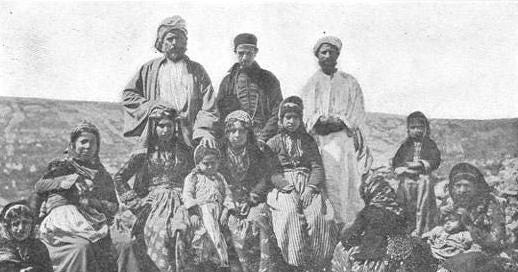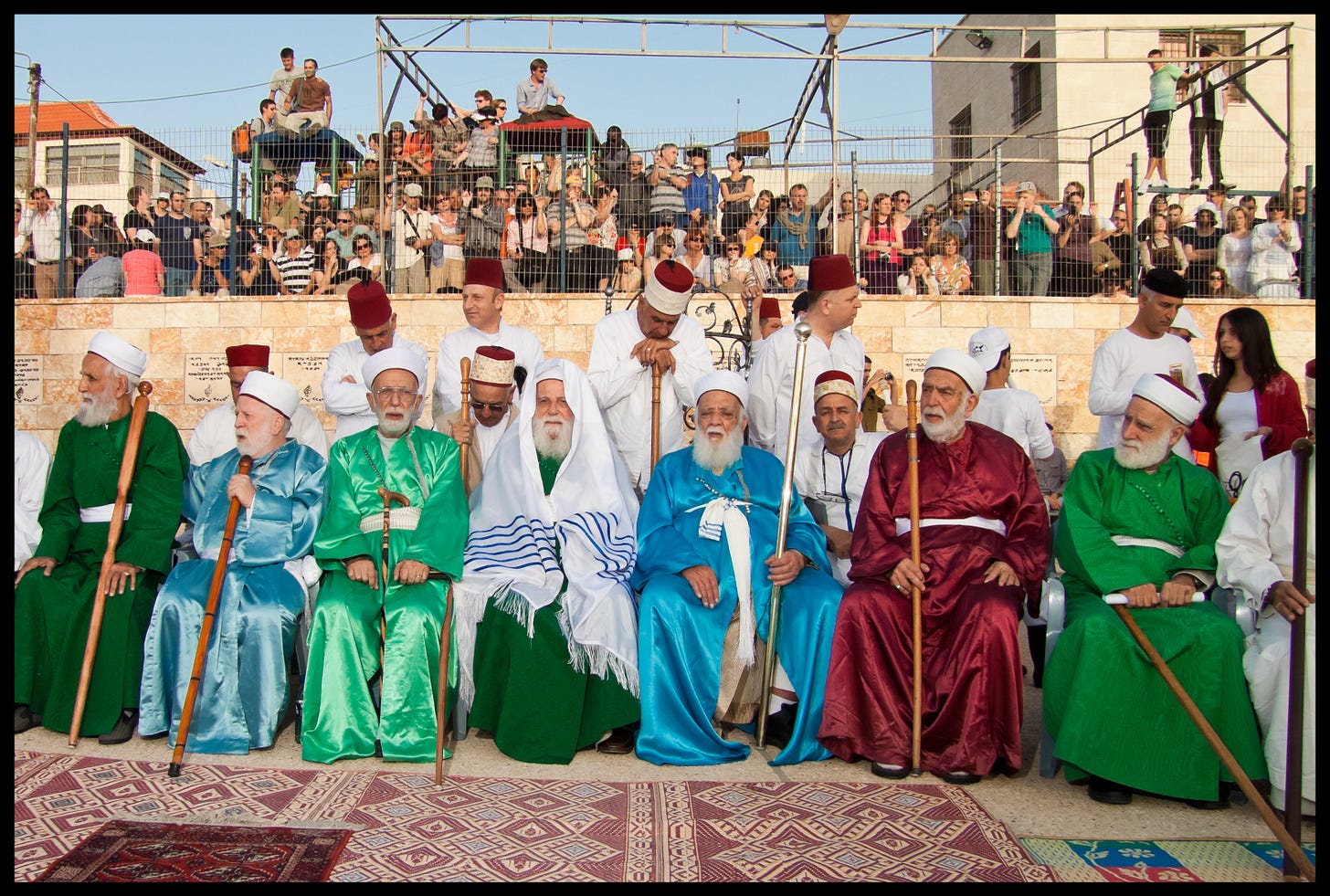The Bible is not a book of history, in the accepted sense. There is no documentary or unshakeable archaeological evidence, for example, for the Flood, The Exodus, The Crossing of the Red Sea or even the conquest of Canaan by the Israelites. All these stories are about the deep and distant past and, whatever one’s religious beliefs, without tangible proof, they cannot be historically verified.
There are a few events though, in the later books of the Bible, than can be treated as history. One of these is the Assyrian conquest of the Northern Kingdom of Israel in 722 BCE and the carrying away of its population into exile (where, according to Jewish tradition, they became the Ten Lost Tribes).
The conquest of the Northern kingdom is known to be a true, historical event because it is mentioned both in the Bible and Assyrian records - fragments of clay tablets unearthed by archaeologists. The two accounts differ in many respects but they both agree on the fundamental fact that the Assyrians conquered the Israelite Kingdom in the late 8th century BCE and deported its population.
In the words of the Assyrian king Tiglath Pileser III:
The land Bit-Humri (= Israel) I brought to Assyria . . I killed their king Peqah and I placed Hoshea as king over them. I received from them ten talents of gold, ... talents of silver, together with their property, and I brought them to Assyria.
And, according to the Bible:
The king of Assyria captured Samaria and deported the Israelites to Assyria. He settled them in Halah, Habor, on the River Gozan and in the towns of Media. (2 Kings, 17,6).
The deportation of defeated populations by victorious armies was quite common in ancient times. According to the Bible, after the Assyrians had deported the Israelite inhabitants of the Northern Kingdom, they brought in people from other lands they had conquered. And it is at this point that we start to lose contact with verifiable history and the story unfolds in two competing directions.
The Bible’s version of events is that because the foreigners who the Assyrians resettled in the old Israelite Kingdom did not fear the God of Israel, God sent lions among them, to kill them. Upon hearing this, the Assyrian king ordered his officials to bring back one of the Israelite priests from exile, to teach the newcomers how to worship the Israelite God. Since they were living in his land, the priest had to teach them to adopt Israelite ways.
This story, as far as anyone knows, is not backed up by Assyrian records. The authors of the Book of Kings probably included it in their account for polemical reasons, to disparage a religion in their own time, that they considered a corruption of their own.
The people who practised the religion that the authors of the Book of Kings didn’t like, still live in the locality. And they tell an alternative version of events. Known as Samaritans, from the name of the Northern Kingdom’s capital city, Samaria, they do not believe that they are descended from foreigners who were taught Judaism by an Israelite priest sent by the Assyrian king. Instead, they believe that they, not the Jews, are the original Israelites and that the religion they practise is the one that Moses taught. The Judaism of the synagogue and the rabbis, they argue, has been corrupted by false teachers.
Their story is quite straightforward. In the Book of Deuteronomy, when the Israelites were nearing the end of their wanderings through the wilderness, Moses instructed them in what they were to do when they reached the Promised Land..Straightaway they were to gather at the twin mountains of Gerizim and Ebal for a ceremony in which they would be reminded of their ethical duties to each other and to God. That indeed, according to the Bible, is exactly what happened. Joshua led the people into the Promised Land, built an altar on one of the two mountains and conducted the ceremony that Moses had ordained. The Samaritans believe that the wo mountains had always been intended as the sacred heart of the land, and that Mount Gerizim was where the first priestly sanctuary was erected.
However, they say, there was a schism amongst the priests. Eli, the priest first mentioned at the beginning of the Book of Samuel, led a breakaway faction away from Gerizim and set up his own sanctuary at Shiloh. Eli was the teacher of the prophet Samuel, Samuel anointed David as king and it was King David’s plan to build the Temple in Jerusalem. In other words, everything that happened in subsequent Jewish history was the result of a rebellion led by the renegade priest, Eli. The Samaritans argue that Jerusalem was never intended to be a holy city. They say that Moses intended the Temple to be built on Mount Gerizim and that they, the Samaritans, are the faithful remnant of the religion that Moses founded.
The Samaritan Torah is not unlike the Jewish Torah, the Five Books of Moses. The books differ in just a few places. In the Samaritan version of the Ten Commandments, the tenth is to build a temple on Mount Gerizim.
The Samaritans have never left Mount Gerizim. Situated above the Palestinian town of Nablus, known in Hebrew as Shechem. it remains their sacred site, their traditional place of worship. Mount Gerizim is where they continue to perform the biblical ritual of eating a sacrificial lamb at Passover.
There is good reason to believe that the Samaritans were once much more prominent and politically important than they are today. During the 4th and 5th centuries CE it is thought there were about 1.5 million Samaritans, living across the land of Israel and stretching into Syria and Egypt. Their numbers subsequently declined dramatically and by 1919 there were only 141 adults in the country who identified as Samaritans. Their population has increased since, they now number around 840, split between two centres, 460 in the Israeli city of Holon and 380 in the exclusively Samaritan village of Kiryat Luza, near Nablus/Shechem..
When the Bible declares that the newcomers whom the Assyrians brought to the region had to be taught Judaism, it is almost certainly trying to create an alternative origin for the Samaritans, implying that they were foreigners not originally related to the Israelites. Science, apparently, does not agree. According to the Israelite-Samaritan Information Institute, “genetic research shows similarities in the DNA of Palestinians, Jews and Samaritans”.
The Bible is not the only source which seems to sideline the Samaritans. The Talmud, finalised around about 500 CE, refers to them frequently in disparaging ways. Later Christian censorship has made it difficult to interpret all the Talmud’s references to Samaritans, but overall they certainly do not get good coverage.
Negative attitudes towards Samaritans are not hard to find. The most obvious indication is in the Christian Bible. A man who had been attacked and beaten by robbers was lying wounded by the roadside. A cohen, a Jewish priest, passed by and ignored him; a Levite passed by and ignored him. Then a Samaritan came along and took care of him. Clearly this parable of the Good Samaritan is an anti-Jewish polemic, designed to show how callous even the priestly Jews were. But the reason why the parable works is because of the reputation of Samaritans. People didn’t like Samaritans and it was regarded as completely out of character for them to behave in a compassionate way. Anyone hearing it would instinctively assume that the Samaritan, like the Jewish priest and Levite would be indifferent to the man lying in the gutter. The parable implies that the Jews are so bad that even a Samaritan is better.
We can’t go back in time to discover just how bad the relationship between ancient Jews and Samaritans really was. The two religions were very similar and it is quite likely that each saw the other as a threat. There must have been some people who converted from one faith to the other, raising the tensions between them. We all know how unpleasant religious hatred can become.
The past is mainly hidden from us but, thanks to the archaeologists who discovered the Assyrian tablets, we can at least identify the moment at which the authors of the Book of Kings diverted their narrative from history into polemic. When they used the historical conquest of the Northern Kingdom of Israel to belittle their neighbouring Samaritan cousins.
Of course, there is another way of looking at it. Perhaps the Bible’s account is correct. Perhaps there really was a priest who taught Judaism to the foreigners, who then became known as Samaritans. If so, the myth would become the Samaritan claim that they are the original Israelites. But that doesn’t explain the apparent DNA evidence.





